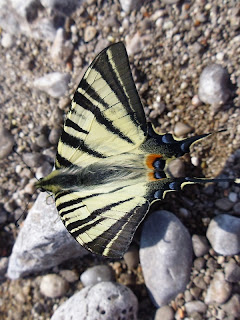The contrast between Croatia and
Italy could hardly have been greater.
Everywhere we have travelled so far the roads have been excellent, the
towns and countryside have been clean and well cared-for and the icing on the
cake is that it has turned hot and sunny with day-time temperatures rising into
the thirties!
We just drove straight across the
neck of land belonging to Slovenia and into a large peninsular in the north of
Croatia called Istria, stopping briefly at the small hill town of Bizet which
was very peaceful but in need of a little TLC.
We spent our first night at Motovun, another hill town.
The small site was half way up
the hill and run by the hotel in the old castle at the top. It was quite a hike up the old cobbled road…
…to reception – but worth
it. We were able to walk round the old
walls and swim in the indoor pool at the hotel.
The views were splendid.
We turned west to get to the
coast. On the way we passed through the
small town of Pazin where there is a very deep gorge which ends suddenly as the
stream disappears into a hole in the ground.
We enjoyed the walk down into the gorge, round an interesting trail with
boards pointing out the different flora and fauna and back up to the other
side. Reaching the top we found a zip
wire right across the gorge to near the castle – we were not sure if we were
glad or sorry it was not operating that day!
We reached the coast at Poreč
with its unusual and interesting church – the Basilica of St Euphrasius where
we had views over the town from the bell tower.
The Basilica had some lovely
mosaics and in the museum we were able to see archaeological finds from much of
the Basilica’s past back to roman times.
Travelling south we came to
Rovinj (the j is pronounced like the y in yes) where we camped right by the
sea...
…and visited the old town next
day. Rovinj, like most of this part of
Croatia, was once ruled by Venice and the winged lion – symbol of St Mark,
Patron Saint of Venice, can still be seen on the gate into the old town.
Continuing south towards Pula we
came across a re-constructed shepherd’s hut remarkably like the houses called
trulli that we saw at Alberobello in Italy.
Perhaps the original settlers in Alberobello came from this area.
Pula’s only claim to fame – its
huge Roman amphitheatre – sits somewhat incongruously between hotels and shops
and overlooking the busy commercial port.
Nothing could have prepared us
for the coast of the Kvarner Gulf south of the city of Rijeka! The journey took much longer than our sat-nav
said it would because we stopped in nearly every layby to look at the ever
changing scene of seemingly barren off-shore islands and limestone cliffs.
In the bays and inlets were
lovely, clean little towns with small harbours and delightful piazzas and the
sea was as calm as as an English village pond.
Wherever we stopped we saw new wild flowers for Jane to photograph such
as this Bladder Campion…
… and interesting wild-life like
the Scarce Swallowtail Butterfly. (Not as
rare as its name would suggest!)
Senj had a castle high up on a
headland and a pretty little Cathedral with an eclectic mix of old and modern
decoration.
From the village of Jablanac…
…we walked round the coast to the
idyllic Zavranica Cove…
… before reaching the Paklenica
National Park.









































